小学六年级英语语法
英语六年级语法

六年级英语语法:
1.一般过去时:
构成:主语+动词过去式(did)
-陈述句:肯定句:I went to Chinatown in New York Yesterday.
否定句:I didn’t do my homework yesterday.
-一般疑问句:Did you visit the museum last week?
-特殊疑问句:What did you do last night?
2.have/has got ...有...
- I’ve got some stamps from China. 我有一些中国的邮票。
- She’s got some books about animals. 她有很多关于动物方面的书籍.
3.一般现在时:
构成:主语+动词原形(do)
主语为单三+单词单数第三人称形式(does)
⏹We always have a big special dinner on Sundays.
⏹She sometimes has eggs for breakfast.
⏹Do you have a pen friend?
⏹Does she like listening to music?
⏹What do you usually do at weekends?
⏹She doesn’t watch TV at night.
4.can的用法
主语+can + 动词原形(do)
⏹I can run fast. But I can’t jump high.
⏹What can you do? Can you swim?。
小学六年级的英语语法
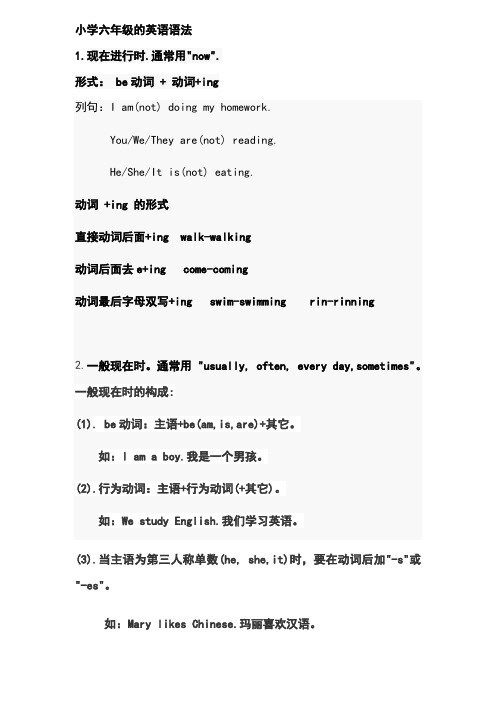
小学六年级的英语语法1.现在进行时.通常用"now".形式: be动词 + 动词+ing列句:I am(not) doing my homework.You/We/They are(not) reading.He/She/It is(not) eating.动词 +ing 的形式直接动词后面+ing walk-walking动词后面去e+ing come-coming动词最后字母双写+ing swim-swimming rin-rinning2.一般现在时。
通常用 "usually, often, every day,sometimes"。
一般现在时的构成:(1). be动词:主语+be(am,is,are)+其它。
如:I am a boy.我是一个男孩。
(2).行为动词:主语+行为动词(+其它)。
如:We study English.我们学习英语。
(3).当主语为第三人称单数(he, she,it)时,要在动词后加"-s"或"-es"。
如:Mary likes Chinese.玛丽喜欢汉语。
一般现在时的变化:(1)be动词的变化。
否定句:主语+ be + not +其它。
如:He is not a worker.他不是工人。
一般疑问句:Be +主语+其它如:-Are you a student?-Yes. I am. / No, I'm not.特殊疑问句:疑问词+一般疑问句。
如:Where is my bike?(2)行为动词的变化。
否定句:主语+ don't( doesn't ) +动词原形(+其它)。
如:I don't like bread.当主语为第三人称单数时,要用doesn't构成否定句。
如:He doesn't often play.一般疑问句:Do( Does ) +主语+动词原形+其它。
六年级英语语法总结
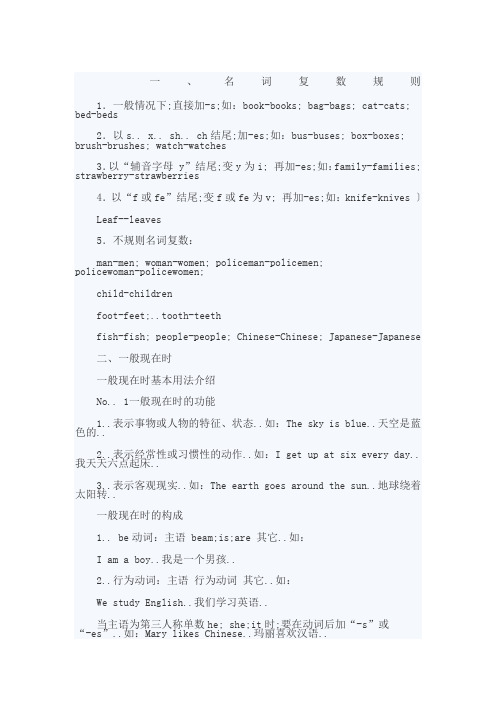
一、名词复数规则1.一般情况下;直接加-s;如:book-books; bag-bags; cat-cats; bed-beds2.以s.. x.. sh.. ch结尾;加-es;如:bus-buses; box-boxes; brush-brushes; watch-watches3.以“辅音字母y”结尾;变y为i; 再加-es;如:family-families; strawberry-strawberries4.以“f或fe”结尾;变f或fe为v; 再加-es;如:knife-knives 〕Leaf--leaves5.不规则名词复数:man-men; woman-women; policeman-policemen;policewoman-policewomen;child-childrenfoot-feet;..tooth-teethfish-fish; people-people; Chinese-Chinese; Japanese-Japanese二、一般现在时一般现在时基本用法介绍No.. 1一般现在时的功能1..表示事物或人物的特征、状态..如:The sky is blue..天空是蓝色的..2..表示经常性或习惯性的动作..如:I get up at six every day..我天天六点起床..3..表示客观现实..如:The earth goes around the sun..地球绕着太阳转..一般现在时的构成1.. be动词:主语 beam;is;are 其它..如:I am a boy..我是一个男孩..2..行为动词:主语行为动词其它..如:We study English..我们学习英语..当主语为第三人称单数he; she;it时;要在动词后加“-s”或“-es”..如:Mary likes Chinese..玛丽喜欢汉语..No.. 2一般现在时的变化1.. be动词的变化..否定句:主语 be not 其它..如:He is not a worker..他不是工人..一般疑问句:Be 主语其它..如:-Are you a student-Yes.. I am.. / No; I‘m not..非凡疑问句:疑问词一般疑问句..如:Where is my bike2..行为动词的变化..否定句:主语don’t doesn‘t 动词原形其它..如:I don’t like bread..当主语为第三人称单数时;要用doesn‘t构成否定句..如:He doesn’t often play..一般疑问句:Do Does 主语动词原形其它..如:- Do you often play football- Yes; I do.. / No; I don‘t..当主语为第三人称单数时;要用does构成一般疑问句..如:- Does she go to work by bike- Yes; she does.. / No; she doesn’t..动词 s的变化规则1.一般情况下;直接加-s;如:cook-cooks; milk-milks2.以s.. x.. sh.. ch.. o结尾;加-es;如:guess-guesses; wash-washes; watch-watches; go-goes3.以“辅音字母y”结尾;变y为i; 再加-es;如:study-studies三、现在进行时1.现在进行时表示现在正在进行或发生的动作;也可表示当前一段时间内的活动或现阶段正在进行的动作..2.现在进行时的肯定句基本结构为be 动词ing..3.现在进行时的否定句在be后加not..4.现在进行时的一般疑问句把be动词调到句首..5.现在进行时的非凡疑问的基本结构为:疑问词不达意 be 主语动词ing但疑问词当主语时其结构为:疑问词不达意 be 动词ing动词加ing的变化规则1.一般情况下;直接加ing;如:cook-cooking2.以不发音的e结尾;去e加ing;如:make-making; taste-tasting3.假如末尾是一个元音字母和一个辅音字母;双写末尾的辅音字母;再加ing;如:run-running; stop-stopping..四、将来时理论及练习一、概念:表示将要发生的动作或存在的状态及打算、计划或预备做某事..句中一般有以下时间状语:tomorrow; next dayweek; month; year…;soon; the day after tomorrow后天等..二、基本结构:①be going to do;②will do..三、否定句:在be动词am; is; arel后加not或情态动词will后加not成won‘t..例如:I’m going to have a picnic this afternoon..→ I‘m not going to have a picnic this afternoon..四、同义句:be going to = willI am going to go swimming tomorrow明天.. = I will go swimming tomorrow..五、一般过去时1.一般过去时表示过去某个时间发生的动作或存在的状态;常和表示过去的时间状语连用..一般过去时也表示过去经常或反复发生的动作..2.Be动词在一般过去时中的变化:⑴am 和is在一般过去时中变为was..was not=wasn’t⑵are在一般过去时中变为were..were not=weren‘t3.句中没有be动词的一般过去时的句子否定句:didn’t 动词原形;如:Jim didn‘t go home yesterday..动词过去式变化规则:1.一般在动词末尾加-ed;如:work__-worked ; cook-cooked2.结尾是e加d;如:live____lived3.末尾只有一个元音字母和一个辅音字母的重读闭音节;应双写末尾的辅音字母;再加-ed;如:stop-stopped4.以“辅音字母y”结尾的;变y为i; 再加-ed;如:study-studied5.不规则动词过去式:am;is-was; are-were; do-did; see-saw; say-said; give-gave; get-got; go-went; come-came; have-had; eat-ate; take-took; run-ran; sing-sang; put-put; make-made; read-read; write-wrote; draw-drew; drink-drank; swim-swam; sit-sat六、人称代词和物主代词主格宾格形容词性名词性I me my mineyou you youryourshe him his hisshe her her hersitit its itswe us our oursthey them theirtheirsBe 动词的用法:1 Am--was Is --was Are--were 口诀:我用am; 你用are; is用在他她它;复数全用are..2 肯定和否定句 I am not from London.. He isnot a teacher.. She isnot in the dining room.. My hair isnot long.. Her eyes arenot small..3 一般疑问句Am I a Chinese Yes; you are.. No; you aren’t.. Are they American Yes; they are.. No; they aren‘t.. Is the cat fat Ye s; it is.. No; it isn’t..人称代词和物主代词1.人称代词主格和宾格的区别:主格通常位于句中第一个动词之前有时候位于than 之后;宾格一般位于动词或介词之后..2.物主代词形容词性与名词性的区别:形容词性用时后面一般要带上名词;名词性则单独使用;后面不带名词..名词复数和动词三单一、名词复数规则1.一般情况下;直接加-s;如:book-books; bag-bags; cat-cats; bed-beds2.以s.. x.. sh.. ch结尾;加-es;如:bus-buses; box-boxes; brush-brushes; watch-watches3.以“辅音字母+y”结尾;变y为i; 再加-es;如:family-families; strawberry-strawberries4.以“f或fe”结尾;变f或fe为v; 再加-es;如:knife-knives5.不规则名词复数: man-men; woman-women; policeman-policemen; policewoman-policewomen; mouse-mice child-childrenfoot-feet;..tooth-teeth fish-fish; people-people; Chinese-Chinese; Japanese-Japanese二.动词三单的变化规则1.一般情况下;直接加-s;如:cook-cooks; milk-milks2.以s.. x.. sh.. ch.. o结尾;加-es;如:guess-guesses;wash-washes; watch-watches; go-goes3.以“辅音字母+y”结尾;变y为i; 再加-es;如:study-studies一般现在时一般现在时基本用法介绍一般现在时的功能1..表示事物或人物的特征、状态..如:The sky is blue..天空是蓝色的..2..表示经常性或习惯性的动作..如:I get up at six every day..我每天六点起床..3..表示客观现实..如:The earth goes around the sun..地球绕着太阳转..一般现在时的构成1.. be动词:主语+beam;is;are+其它..如:I am a boy..我是一个男孩..2..行为动词:主语+行为动词+其它..如:We study English..我们学习英语..当主语为第三人称单数he; she;it时;要在动词后加“-s”或“-es”..如:Mary likes Chinese..玛丽喜欢汉语..一般现在时的变化1.. be动词的变化..否定句:主语+ be + not +其它..如:He is nota worker..他不是工人..一般疑问句:Be +主语+其它..如:-Are you a student -Yes.. I am.. / No; I‘m not..特殊疑问句:疑问词+一般疑问句..如:Where is my bike2..行为动词的变化..否定句:主语+ don’t doesn‘t +动词原形+其它..如:I don’t like bread.. 当主语为第三人称单数时;要用doesn‘t构成否定句..如:He doesn’t often play..一般疑问句:Do Does +主语+动词原形+其它..如:- Do you often play football - Yes; I do.. / No; I don‘t..当主语为第三人称单数时;要用does构成一般疑问句..如:- Does she go to work by bike - Yes; she does.. / No; she doesn’t..特殊疑问句:疑问词+一般疑问句..如:How does your father go to work现在进行时1.现在进行时表示现在正在进行或发生的动作;也可表示当前一段时间内的活动或现阶段正在进行的动作..2.现在进行时的肯定句基本结构为be+动词ing..3.现在进行时的否定句在be后加not..4.现在进行时的一般疑问句把be动词调到句首..5.现在进行时的特殊疑问的基本结构为:疑问词不达意 + be + 主语 + 动词ing但疑问词当主语时其结构为:疑问词不达意 + be + 动词ing动词加ing的变化规则1.一般情况下;直接加ing;如:cook-cooking2.以不发音的e结尾;去e加ing;如:make-making; taste-tasting3.如果末尾是一个元音字母和一个辅音字母;双写末尾的辅音字母;再加ing;如:run-running; stop-stopping 将来时一、概念:表示将要发生的动作或存在的状态及打算、计划或准备做某事..句中一般有以下时间状语:tomorrow; next dayweek; month; year…;soon; the day after tomorrow后天等..二、基本结构:①be going to + do;②will+ do..三、否定句:在be动词am; is; arel后加not或情态动词will后加not成won‘t..例如:I’m going to have a picnic this afternoon..→ I‘m not going to have a picnic this afternoon.. 四、一般疑问句: be或will 提到句首;some改为any; and改为or;第一二人称互换..例如:We are going to go on a n outing this weekend.. → Are you going to go on an outing this weekend五、对划线部分提问:一般情况;一般将来时的对划线部分有三种情况..1.. 问人..Who 例如:I’m going to New York soon.. →Who‘s going to New York soon..2.. 问干什么..What … do..例如: My father is going to watcha race with me this afternoon.. →What is your father going to do with you this afternoon..3.. 问什么时候..When..例如:She’s going to go to bed at nine.. →When is she going to bed 六、同义句:be going to = willI am going to go swimming tomorrow明天.. = I will go swimming tomorrow..一般过去时1.一般过去时表示过去某个时间发生的动作或存在的状态;常和表示过去的时间状语连用..一般过去时也表示过去经常或反复发生的动作感谢..2.Be动词在一般过去时中的变化:⑴am 和is在一般过去时中变为was..was not=wasn’t⑵are在一般过去时中变为were..were not=weren‘t⑶带有was或were的句子;其否定、疑问的变化和is; am; are一样;即否定句在was或were后加not;一般疑问句把was或were调到句首..3.句中没有be动词的一般过去时的句子否定句:didn’t +动词原形;如:Jim didn‘t go home yesterday..一般疑问句:在句首加did;句子中的动词过去式变回原形..如:Did Jim go home yesterday 特殊疑问句:⑴疑问词+did+主语+动词原形如:What did Jim do yesterday⑵疑问词当主语时:疑问词+动词过去式如:Who went to homeyesterday动词过去式变化规则:1.一般在动词末尾加-ed;如:pull-pulled; cook-cooked2.结尾是e加d;如:taste-tasted3.末尾只有一个元音字母和一个辅音字母的重读闭音节;应双写末尾的辅音字母;再加-ed;如:stop-stopped4.以“辅音字母+y”结尾的;变y为i; 再加-ed;如:study-studied5.不规则动词过去式: am;is-was; are-were; do-did; see-saw; say-said; give-gave; get-got; go-went; come-came; have-had;eat-ate; take-took; run-ran; sing-sang; put-put; make-made;read-read; write-wrote; draw-drew; drink-drank; fly-flew;ride-rode; speak-spoke; sweep-swept; swim-swam; sit-satThere be 句型与have; has的区别1、There be 句型表示:在某地有某物或人2、在there be 句型中;主语是单数;be 动词用is ;主语是复数;be 动词用are ;如有几件物品;be 动词根据最近be 动词的那个名词决定..3、there be 句型的否定句在be 动词后加not ; 一般疑问句把be 动词调到句首..4、there be句型与havehas 的区别:there be 表示在某地有某物或人;havehas 表示某人拥有某物..5、some 和any 在there be 句型中的运用:some 用于肯定句; any 用于否定句或疑问句..6、and 和or 在there be句型中的运用:and 用于肯定句; or 用于否定句或疑问句..7、针对数量提问的特殊疑问句的基本结构是: How many + 名词复数 + are there + 介词短语 How much + 不可数名词 + is there + 介词短语8、针对主语提问的特殊疑问句的基本结构是:What’s + 介词短语。
小学六年级英语语法知识【三篇】

小学六年级英语语法知识【三篇】一词类动词、名词和形容词不太容易区分,如不能一眼看出,可用如下方法:先用“一(量词)”(如:一个、一张等)和这个词连起来说,如说得通,一般认为是名词;说不通再用“很”去判断,就是把“很”和为个词连起来说,说得通一般就是形容词;都说不通就是动词。
(目前我们学过的,以后可能不同)(另外一些很明显的,如人称代词、数词、情态动词等一下就可以知道)1、动词这里所说的动词是指各种动词总称,其中包括行为动词(就是我们平时总说的那种动词)、be动词、情态动词。
( 1)行为动词就是我们平时上课时说的动词,表示某一动作或行为。
如:sweep、live等。
行为动词我们已学过它们的四种形式:原形、+s/es、+ed、+ing,具体判断方法如下:↗有,就加ing 读句子→读该单词→认识该单词→理解意思→看有无be动词(若是be going to 就用原形)↘没有,再看情态动词↗有,就用原形↗有,就加ed↘没有,再看有无表示过去的时间状语↗是第三人称单数就加s或es↘没有,再看主语↘不是第三人称单数就用原形( 2)be动词a、Am--was Is --was Are--were 口诀:我用am, 你用are, is用在他她它,所有复数全用are。
b、肯定和否定句 I am (not) from London. He is(not) a teacher. She is(not) in the dining room. My hair is(not) long. Her eyes are(not) sm all.c、一般疑问句 Am I a Chinese? Yes, you ar e. No, you aren’t. Are they American? Yes, they are. No, they aren’t. Is the cat fat? Yes, i t is. No, it isn’t.我们现在学过的be动词大致分两类:is、am、are为一类,一般用于一般现在时、现在进行时和一般将来时中,was和were为另一类,一般用于一般过去时。
六年级英语必会语法知识点

六年级英语必会语法知识点英语作为一门语言,它的语法规则是我们学习英语不可或缺的一部分。
对于六年级的学生来说,掌握英语的基本语法知识点对于提高语言表达能力至关重要。
本文将重点介绍六年级英语必会的语法知识点,帮助学生们更好地理解和运用英语语法。
一、动词时态1. 一般现在时:表示经常性或普遍性的动作或状态。
常用的标志词有often, usually, always等。
例句:I often go to the park on weekends.2. 现在进行时:表示正在进行的动作。
常用的标志词有now, at the moment等。
例句:She is studying in the library right now.3. 一般过去时:表示过去发生的动作或状态。
常用的标志词有yesterday, last week等。
例句:We watched a movie last night.4. 过去进行时:表示过去某一时刻正在进行的动作。
常用的标志词有at that time, when等。
例句:She was sleeping when I called her.5. 一般将来时:表示将来要发生的动作或状态。
常用的标志词有tomorrow, next week等。
例句:They will visit their grandparents this weekend.二、形容词和副词的比较级和最高级1. 比较级:表示两个人或物之间的比较。
形容词和副词的比较级通常在词尾加-er。
例句:This book is longer than that one.2. 最高级:表示三个或三个以上人或物之间的比较。
形容词和副词的最高级通常在词尾加-est。
例句:She is the tallest girl in her class.三、名词的单数和复数形式1. 名词的复数形式通常在词尾加-s,但也有一些特殊的变化规则。
例句:My friend has many books.2. 部分名词的复数形式是不规则的,需要进行记忆。
小学六年级英语语法全

一、人称代词二、指示代词三、疑问代词四、不定代词五、数字和日期六年级英语语法知识汇总一、词类:1、动词:行为动词、be动词、情态动词。
(1)行为动词原形、+s/es、+ed、+ing,具体判断方法如下:(2)be动词a、Am--was Is --was Are--were 口诀:我用am, 你用are, is用在他她它,所有复数全用are。
b、肯定和否定句I am (not) from London. He /She is(not) a teacher. My hair is(not) long. Hereyes are(not) small.c、一般疑问句 Am I …? Yes, you are. No, you aren’t. Are you/they…? Yes,we/ they are.No,we/ they aren’t. Is the cat fat? Yes, it is. No, it isn’t.is、am、are为一类,一般用于一般现在时、现在进行时和一般将来时中。
was和were为另一类,一般用于一般过去时。
(3)情态动词can、must、should、would、may。
情态动词后动词总是用原形。
(不受其他任何条件影响)2、名词这里强调两点:不可数名词都默认为单数,所以总是用is或者was。
如何加后缀:a.一般情况下,直接加-s,如:book-books, bag-bags, cat-cats, bed-bedsb.以s. x. sh. ch结尾,加-es,如:bus-buses, box-boxes, brush-brushes, watch-watchesc.以“辅音字母+y”结尾,变y为i, 再加-es,如:family-families, strawberry-strawberriesd.以“f或fe”结尾,变f或fe为v, 再加-es,如:knife-knives e.不规则名词复数: man-men, woman-women, policeman-policemen, policewoman-policewomen,mouse-mice child-children foot-feet ,.tooth-teeth fish-fish, people-people,Chinese-Chinese, Japanese-Japanese3、形容词(包括副词)形容词表示某一事物或的特征,副词表示某一动作的特征。
完整版)六年级英语语法知识点汇总
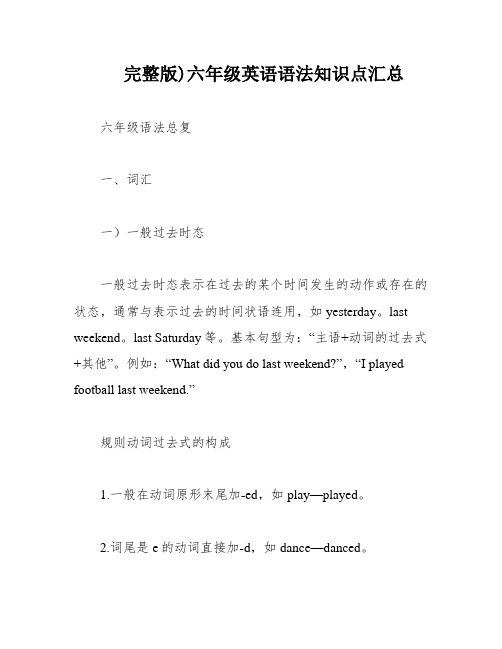
完整版)六年级英语语法知识点汇总六年级语法总复一、词汇一)一般过去时态一般过去时态表示在过去的某个时间发生的动作或存在的状态,通常与表示过去的时间状语连用,如yesterday。
last weekend。
last Saturday等。
基本句型为:“主语+动词的过去式+其他”。
例如:“What did you do last weekend?”,“I played football last weekend.”规则动词过去式的构成1.一般在动词原形末尾加-ed,如play—played。
2.词尾是e的动词直接加-d,如dance—danced。
3.末尾只有一个辅音字母的重读闭音节词,先双写这个辅音字母,再加-ed,(停止)ped。
4.结尾是“辅音字母+y”的动词,变“y”为“i”,再加-ed,如study--studied。
一些不规则变化的动词过去式am/is—was,are—were,see—saw,take—took,read—read,sleep(睡觉)—slept,go—went,come—came,swim—swam,fly—flew,e—became,do—did,get—got,have—had,draw—drew,say—said,hurt—hurt,win—won,tell—told,will—would,eat—ate,cut(切)--cut,sit(坐)—sat,think—thought,find—found,make—made,drink—drank,run(跑)—ran,wear—wore,begin(开始)—began,buy—bought,give(给)—gave,sing—sang。
二)一般现在时态一般现在时态表示包括现在时间在内的一段时间内经常发生的动作或存在的状态,表示惯性或客观存在的事实和真理,通常与often。
always。
usually。
sometimes。
六年级英语语法总结

六年级英语语法总结一、动词时态1. 现在进行时定义:表示现在正在进行的动作或存在的状态。
结构:be动词(am/is/are)+动词的现在分词形式(-ing)。
例句:I am doing my homework. 我正在做作业。
2. 现在完成时定义:表示过去发生的动作对现在造成的影响或结果。
结构:have/has+动词的过去分词形式(-ed)。
例句:I have finished my homework. 我已经完成了作业。
3. 一般过去时定义:表示过去某个时间发生的动作或存在的状态。
结构:动词的过去式。
例句:I did my homework yesterday. 我昨天做了作业。
二、名词1. 可数名词和不可数名词可数名词:可以计数的名词,如book(书)、apple(苹果)。
不可数名词:无法计数的名词,如water(水)、milk(牛奶)。
2. 名词的复数形式大多数名词的复数形式是在词尾加上s或es,如books、apples。
三、代词1. 人称代词:表示人称的代词,如I(我)、you(你)、he(他)、she(她)。
2. 物主代词:表示所有关系的代词,如my(我的)、your(你的)、his(他的)、hers(她的)。
四、形容词和副词1. 形容词:用来描述名词或代词的性质或特征,如red(红色的)、big(大的)。
2. 副词:用来描述动词、形容词或其他副词的程度或方式,如slowly(慢慢地)、quickly(快速地)。
五、介词1. 表示时间的介词:如in(在...里)、on(在...上)、at(在...点)。
2. 表示位置的介词:如in(在...内)、on(在...上)、at(在...处)。
六、定冠词和不定冠词1. 定冠词:表示特指,如the(这个)、that(那个)。
2. 不定冠词:表示泛指,如a(一个)、an(一个)。
七、句式结构1. 陈述句:陈述一个事实或观点,如I am a student.(我是一个学生。
小学六年级英语必须要掌握的语法知识点(完美版)
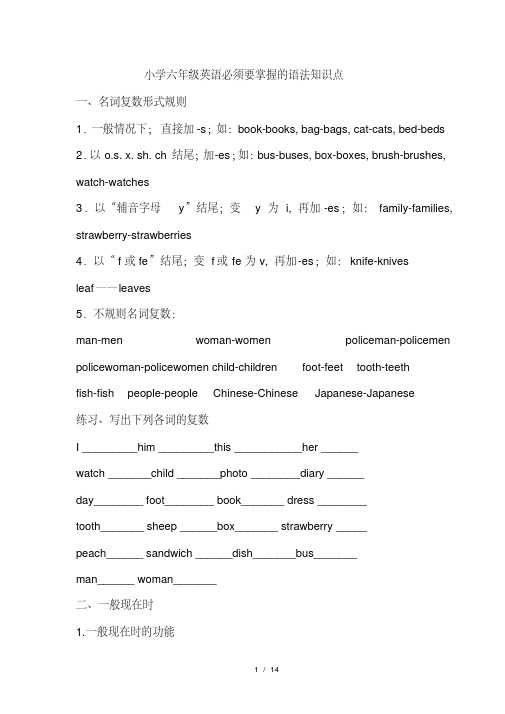
小学六年级英语必须要掌握的语法知识点一、名词复数形式规则1.一般情况下;直接加-s;如:book-books, bag-bags, cat-cats, bed-beds 2.以o.s. x. sh. ch结尾;加-es;如:bus-buses, box-boxes, brush-brushes, watch-watches3.以“辅音字母y”结尾;变y为i, 再加-es;如:family-families, strawberry-strawberries4.以“f或fe”结尾;变f或fe为v, 再加-es;如:knife-knives leaf——leaves5.不规则名词复数:man-men woman-women policeman-policemen policewoman-policewomen child-children foot-feet tooth-teethfish-fish people-people Chinese-Chinese Japanese-Japanese练习、写出下列各词的复数I _________him _________this ___________her ______watch _______child _______photo ________diary ______day________ foot________ book_______ dress ________tooth_______ sheep ______box_______ strawberry _____peach______ sandwich ______dish_______bus_______man______ woman_______二、一般现在时1.一般现在时的功能○1表示事物或人物的特征、状态.如:The sky is blue.天空是蓝色的.○2表示经常性或习惯性的动作.如:I get up at six o’clock every day.我天天六点起床.○3表示客观现实.如:The earth goes around the sun.地球绕着太阳转.2.一般现在时的构成○1肯定句: a. be动词:(有一顺口溜体现了它的用法:我用am ;你用 are ;is 用于他;她;它, 单数is;复数are..)主语+ be(am /is/are)+其他如: I am a boy.我是一个男孩.b.行为动词(实义动词):主语+行为动词+其他[除主语是第三人称单数外;都用动词原形;当主语是第三人称时;则在行为动词词尾加-s或-es.]如:We study English.我们学习英语.She goes to work by bike. 她骑自行车去上班.○2否定句: a.主语+ be(am /is/are) +not + 其他如: I am not a boy.b. 主语+don't/doesn't+行为动词原形+其他如:We don’t study English. She doesn't go to work by bike.○3一般疑问句: a. Be(Am /Is /Are)+ 主语+ 其他?简略回答: (肯) Yes,主语 + be(am /is/are). (否) No,主语 + be(am /is/are)+not.如: Are you a boy?你是一个男孩吗?(肯)Yes,I am. (否) No, I’m not.b. Do/Does+主语+ 其他?简略回答: (肯) Yes,主语+ do/does. (否) No,主语 + don't/doesn't.如: Do you study English? (肯)Yes,we do. (否) No, we don’t. - Does shego to work by bike? - Yes, she does. / No, she doesn't.○4特殊疑问句:特殊疑问词+一般疑问句?如: a. be动词:Who are you?b.行为动词:What do you do? How does she go to work?3.动词三单的变化规则(即“如何从动词原形变为第三人称单数”)○1一般情况下;直接加-s;如:cook-cooks get-gets○2以o.s.x.sh.ch结尾,直接加-es;如:wash-washes, watch-watches, go-goes○3以“辅音字母y”结尾;变y为i, 再加-es;如:study-studies一般现在时用法专练:一、写出下列动词的第三人称单数drink ________ go _______ stay ________ make ________look _________ have_______ pass_______ carry ____________study_______ brush________ do_________ teach_______wash_______二、用括号内动词的适当形式填空.1. He often ________(have) dinner at home.2. Daniel and Tommy _______(be) in Class One.3. We _______(not watch) TV on Monday.4. Nick _______(not go) to the zoo on Sunday.5. ______ they ________(like) the World Cup?6. What _______they often _______(do) on Saturdays?7. _______ your parents _______(read) newspapers every day?8. The girl _______(teach) us English on Sundays.9. She and I ________(take) a walk together every evening.10. There ________(be) some water in the bottle.11. Mike _______(like) cooking.12. They _______(have) the same hobby.13. My aunt _______(look) after her baby carefully.14. You always _______(do) your homework well.m staying in bed.15. I _______(be) ill. I’16. She _______(go) to school from Monday to Friday.17. Liu Tao _______(do) not like PE.18. The child often _______(watch) TV in the evening.19. Su Hai and Su Yang _______(have) eight lessons this term.20. -What day _______(be) it today? -It’s Saturday三、现在进行时1.现在进行时表示现在正在进行或发生的动作;也可表示当前一段时间内的活动或现阶段正在进行的动作.2.现在进行时的构成:be+动词的ing〔现在分词〕形式.肯定句:主语+be动词+动词ing+其他.如:We are studying.否定句:主语+be动词+not+动词ing+其他.如:We aren’t studying.一般疑问句:Be动词+主语+动词ing+其他.如:Are you studying?肯定回答:Yes+主语+be动词.如:Yes,we are.否定回答:No+主语+be动词+not.如:No,we aren’t.;但是am not在;are not可以缩写成aren’t(注:is not可以缩写成isn‘t现代英语中不可以缩写.)特殊疑问句:特殊疑问词+一般疑问句?如:What are you doing?现在分词的变化规则1.一般情况下;直接加ing;如:cook-cooking think---thinking2.以不发音的字母e结尾的单词,去掉字母e;再加ing 如:make-making have---having3.以重读闭音节(重读闭音节即两个辅音中间夹一个元音并且重读的音节)结尾;呈现“辅;元;辅”结构的动词;双写末尾的辅音字母;再加ing 如: stop---stopping sit---sitting run---running4 以ie结尾的动词;把ie改为y ;再加ing die---dying lie---lying现在进行时专项练习:一、写出下列动词的现在分词:play________ run__________ swim _________make__________go_________ like________ write________ study__________read________ have_________ sing ________ dance_________put_________ see________ buy _________ love____________stop_________ sit ________ begin________ shop___________二、用所给的动词的正确形式填空:1.The boy __________________ ( draw)a picture now.2. Listen .Some girls _______________ ( sing)in the classroom .3. My mother _________________ ( cook )some nice food now.4. What _____ you ______ ( do ) now?5. Look . They _______________( have) an English lesson .6.They ____________(not ,water) the flowers now.7.Look! the girls ________________(dance )in the classroom .8.What is our granddaughter doing? She _________(listen ) to music.ow. We _____________(have)supper now9. It’s 5 o’clock n10.______Helen____________(wash )clothes? Yes ,she is .四、一般将来时一、概念:表示将要发生的动作或存在的状态及打算、计划或预备做某事.句中一般有以下时间状语:tomorrow, next day(week, month, year…),soon, the day after tomorrow(后天)等.二、基本结构:肯定句: a. 主语+shall/will+do+其他.(will可用于所有人称;shall只用于第一人称I和we) 如: I will go swimming tomorrow.b. 主语+ be going to + do+其他.(注意:be 动词要与主语的人称和数一致)如:I am going to go swimming tomorrow.否定句:a. 主语+shall/will+not+do(will not 可缩写成won’t)b. 主语+ be+ not+ going to +do 如:I won’t go swimming tomorrow. I am not going to go swimming tomorrow.一般疑问句:a. Shall/Will+主语+ do+其他? b. Be+主语+going to+do+其他?如:Will you go swimming tomorrow? Are you going to go swimmingtomorrow?特殊疑问句:特殊疑问词+一般疑问句?如:What will you go tomorrow? What are you going to do tomorrow?练习填空.1. 我打算明天和朋友去野炊.I_____ _______ _________ have a picnic with my friends.I ________ have a picnic with my friends.2.我们将要学习英语We _____ _______ _________ learn English.We ________ learn English.五、一般过去时1.一般过去时表示过去某个时间发生的动作或存在的状态;常和表示过去的时间状语连用,如:yesterday;yesterday morning;yesterday afternoon;yesterday evening;the day before yesterday(前天);last night;last week;last month; last year等. 一般过去时也表示过去经常或反复发生的动作.2.一般过去式的基本结构:Be动词在一般过去时中的变化:⑴am 和is在一般过去时中变为was.(was not=wasn’t)⑵are在一般过去时中变为were.(were not=weren’t)○1肯定句:主语+动词过去式+其他.如:I was in Shanghai last month.上个月我在上海.We went to Shanghai last month.我们上个月去了上海.○2否定句:a主语+wasn’t/weren’t+其他.如: I wasn’t in Shanghai last month.b. 主语+didn’t+动词原形+其他.(did + not = didn't)如:We didn’t go to Shanghai last month.○3一般疑问句: a.Was/Were+主语+其他?如:Were you in Shanghai last month?b. Did+主语+动词原形+其他?如:Did you go to Shanghai last month? ○4特殊疑问句:特殊疑问词+一般疑问句?如:Where were you last month? Where did you go last month?动词过去式变化规则:1.一般情况下;在动词原形后面加-ed;如:look→looked play→played start→started visit→visited2.以不发音e结尾的动词;在词尾直接加-d;如: live→lived use→used 3.以“辅音字母+ y”结尾的动词;先将 y 改为i ,再加–ed;如: study →studied, try→tried fly→flied4.以重读闭音节(即辅音+元音+辅音)或r音节结尾;末尾只有一个辅音字母的动词;要先双写这个辅音字母后;再加–ed;如: stop→stopped plan→planned5.不规则动词过去式:练习一、写出下列动词的过去式is/am_________ plant________ are ________drink_________ play_______ go________ make ________does_________ dance________ worry________ ask _____taste_________ eat__________ put ______kick_________ pass_______ do ________练习二、用be动词的适当形式填空1. I _______ at school just now.2. He ________ at the camp last week.3. We ________ students two years ago.4. They ________ on the farm a moment ago.5. Yang Ling ________ eleven years old last year.6. There ________ an apple on the plate yesterday.7. There ________ some milk in the fridge on Sunday.8. The mobile phone _______ on the sofa yesterday evening.练习三、用所给动词的适当形式填空1. I ______ (watch) a cartoon on Saturday.2. Her father _______ (read) a newspaper last night.3. We _________ to zoo yesterday, we _____ to the park. (go)4. ______ you _______ (visit) your relatives last Spring Festival?5. ______ he _______ (fly) a kite on Sunday? Yes, he ______.6. Gao Shan _______ (pull) up carrots last National Day holiday.7. I ____________ (sweep) the floor yesterday, but my mother ______.8. What ______ she _______ (find) in the garden last morning? She__________ (find) a beautiful butterfly.六、人称代词和物主代词第一人称第二人称第三人称单数复数单数复数单数复数人称代词主格I we you you she he it they 宾格me us you you her him it them物主代词形容词性my our your your her his its their 名词mine ours yours yours hers his its theirs人称代词指代人或物;在句中作主语或宾语;所以有主格和宾格.宾格代词用于替代处于宾语位置上的名词;可以用作直接宾语和间接宾语. 如:I am a student. (I 主语) Please help me. (me 直接宾语) Give me a book. (me 间接宾语)物主代词是表示所有关系的一种代词;亦称所有格代词.物主代词有两种形式:形容词性物主代词和名词性物主代词.形容词性物主代词为限定词;放在名词或名词短语前作定语.如:This is my book.名词性物主代词起名词的作用;后面不可以再接名词.在句子中可以作主语、宾语或表语.如: Your pen is red. Mine is black.你的钢笔是红色的,我的是黑色的.He didn’t use his ink. He used mine.他没有用他自己的墨水;他用了我的.习题一、用所给词的适当形式填空1. That is not _________ kite. That kite is very small, but _________ isvery big. ( I )2. The dress is _________. Give it to _________. ( she )3. Is this _________ watch? (you) No, it’s not _________ . ( I )4. _________ is my brother. _________ name is Jack. Look! Those stamps are _________. ( he )二、用am, is, are 填空1. I ______ a boy. ______ you a boy? No, I _____ not.2. The girl______ Jack's sister.3. The dog _______ tall and fat.4. The man with big eyes _______ a teacher.5. ______ your brother in the classroom?6. Where _____ your mother? She ______ at home.7. How _______ your father?8. Mike and Liu Tao ______ at school.9. Whose dress ______ this?10. Whose socks ______ they?七、形容词、副词的比较级和最高级(一)构成规则1.一般单音节词和少数以-er;-ow结尾的双音节词;比较级在后面加-er;最高级在后面加-est(1)单音节词如:small→smaller→smallest short→shorter→shortest (2)双音节词如:clever→cleverer→cleverest narrow→narrower→narrowest2.以不发音e结尾的单音节词;比较在原级后加-r;最高级在原级后加-st 如:large→larger→largest nice→nicer→nicest3.在重读闭音节(即:辅音+元音+辅音)中;先双写末尾的辅音字母;比较级加-er;最高级加-est;如:big→bigger→biggest hot→hotter→hottest fat→fatter→fattest4.以“辅音字母+y”结尾的双音节词;把y改为i;比较级加-er;最高级加-est如:easy→easier→easiest heavy→heavier→heaviest busy→busier→busiest happy→happier→happiest5.其他双音节词和多音节词;比较级在前面加more;最高级在前面加most如:beautiful→more beautiful→most beautiful different→more different→most different easily→more easily→most easily注意:(1)形容词最高级前通常必须用定冠词 the;副词最高级前可不用. 如: The Sahara is the biggest desert in the world.(2)形容词most前面没有the;不表示最高级的含义;只表示"非常". It is a most important problem. =It is a very important problem.6.有少数形容词、副词的比较级和最高级是不规则的;必须熟记. 如:good→better→best well→better→best bad→worse→worst ill→worse→worst old→older/elder→oldest/eldest many/much→more→most little→less→least far →further/farther→ furthest/farthest(二)形容词、副词的比较级和最高级的用法1.“A + be +形容词比较级 + than + B”意思为“A比B更,,”.如:This tree is taller than that one. 这棵树比那棵树高.注意:①在含有连词than的比较级中;前后的比较对象必须是同一范畴;即同类事物之间的比较.②在比较级前面使用much;表示程度程度“强得多”.如:A watermelon is much bigger than an apple.③ very, quite一般只能修饰原级;不能修饰比较级.2.“比较级 + and + 比较级”或“more and more +原级”表示“越来越,,”如:It is getting cooler and cooler. 天气越来越凉爽.3.在含有or的选择疑问句中;如果有两者供选择;前面的形容词要用比较级形式.如:Who is taller,Tim or Tom? 谁更高;Tim还是Tom?4. “the +比较级..., the+比较级”;表示“越...越...”.如: The sooner;the better. 越快越好.习题一、出下列形容词、副词的原级;比较级;最高级small→→→fatter→hot→________ →________ thin→________→ _________heavy→________ →________ bad→________→ _________习题二、用适当形式填空:1. Bob is ________ ( young ) than Fred but __________ (tall) than Fred2. Yingtian is not as ___________ (tall) asYongxian.3. Almost all the students' faces are the same but Li Deming looks ____ ___ (fat) than before .4. Which is _________ (heavy), a hen or a chicken?5.-- How _________ (tall) is Sally?-- She' s 1.55 metres ________ (tall). What about Xiaoling? -- She' s only 1.40 metres ______ (tall). She is much _______(short) than Sally. She is also the _______ (short)girlin theclass.。
英语所有语法知识点六年级

英语所有语法知识点六年级一、动词时态1. 一般现在时:用于表示经常性或普遍性的动作、情况或状态例句:I play football every Sunday.2. 一般过去时:用于表示过去某个时间发生的动作或状态例句:She watched a movie yesterday.3. 一般将来时:用于表示将来要发生的动作或情况例句:I will visit my grandparents next week.4. 进行时态:用于表示正在进行的动作例句:They are eating lunch now.5. 完成时态:用于表示已经完成的动作或状态例句:He has finished his homework.二、名词1. 可数名词与不可数名词例句:There are three apples on the table. (可数名词) I want some water. (不可数名词)2. 单数名词与复数名词例句:The dog is cute. (单数名词)The dogs are playing in the park. (复数名词)3. 名词所有格例句:Tom's book is on the table.三、形容词与副词1. 形容词用于修饰名词,表示名词的性质、特征或状态例句:She has a beautiful flower.2. 副词用于修饰动词、形容词或副词,表示方式、程度或时间等例句:He runs quickly.四、冠词1. 不定冠词(a/an)用于泛指单数可数名词前例句:I see an apple.2. 定冠词(the)用于特指或泛指某个人或物例句:The cat is on the table.五、代词1. 主格代词用于作主语例句:She is my friend.2. 宾格代词用于作宾语例句:He gave me a present.3. 物主代词表示所属关系例句:This is his book.六、介词1. 介词用于表示位置、时间、原因、方式等例句:He is in the park.2. 一些常见介词:in, on, at, with, for, to 等七、连词1. 并列连词用于连接同等重要的词、短语、句子等例句:I like apples and oranges.2. 从属连词用于引导从句例句:She is happy because she won the game.八、疑问词1. 疑问词用于构成疑问句例句:Where is the book?九、形容词比较级与最高级1. 形容词比较级用于表示两者之间的比较例句:She is taller than her sister.2. 形容词最高级用于表示三者或三者以上的比较例句:She is the tallest girl in the class.十、情态动词1. 情态动词用于表示能力、可能性、许可等例句:I can swim.十一、直接引语与间接引语1. 直接引语直接引述别人的原话例句:He said, "I am happy."2. 间接引语是对别人的话进行转述例句:He said he was happy.以上是六年级英语的所有语法知识点,掌握这些知识将会帮助你更好地理解和运用英语语法。
六年级英语语法基础知识大全
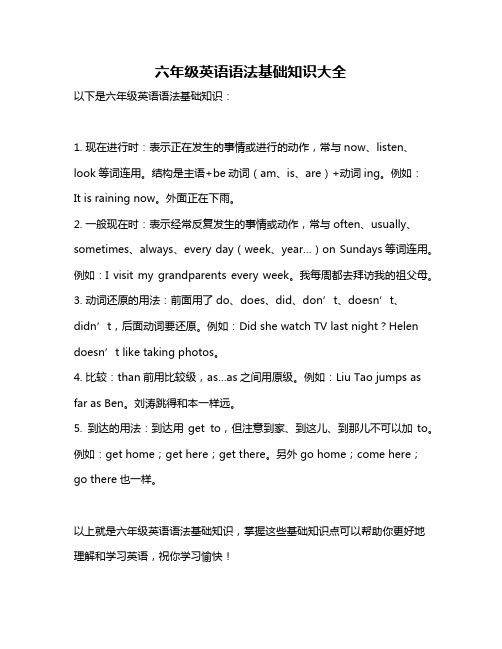
六年级英语语法基础知识大全
以下是六年级英语语法基础知识:
1. 现在进行时:表示正在发生的事情或进行的动作,常与now、listen、look等词连用。
结构是主语+be动词(am、is、are)+动词ing。
例如:
It is raining now。
外面正在下雨。
2. 一般现在时:表示经常反复发生的事情或动作,常与often、usually、sometimes、always、every day(week、year…)on Sundays等词连用。
例如:I visit my grandparents every week。
我每周都去拜访我的祖父母。
3. 动词还原的用法:前面用了do、does、did、don’t、doesn’t、didn’t,后面动词要还原。
例如:Did she watch TV last night?Helen doesn’t like taking photos。
4. 比较:than前用比较级,as…as之间用原级。
例如:Liu Tao jumps as far as Ben。
刘涛跳得和本一样远。
5. 到达的用法:到达用get to,但注意到家、到这儿、到那儿不可以加to。
例如:get home;get here;get there。
另外go home;come here;go there也一样。
以上就是六年级英语语法基础知识,掌握这些基础知识点可以帮助你更好地理解和学习英语,祝你学习愉快!。
小学六年级英语语法知识点汇总
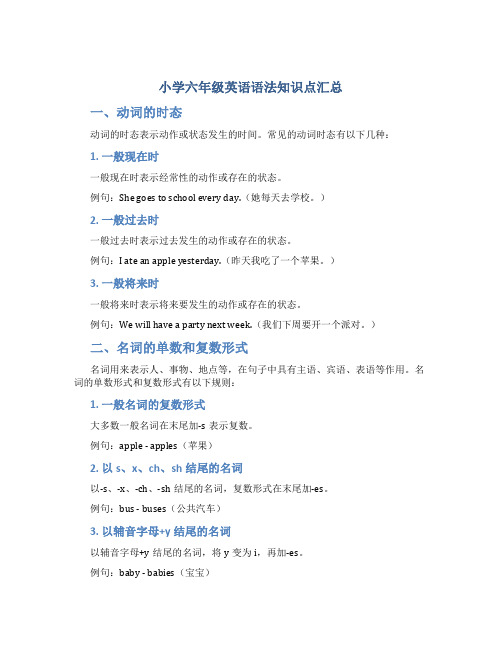
小学六年级英语语法知识点汇总一、动词的时态动词的时态表示动作或状态发生的时间。
常见的动词时态有以下几种:1. 一般现在时一般现在时表示经常性的动作或存在的状态。
例句:She goes to school every day.(她每天去学校。
)2. 一般过去时一般过去时表示过去发生的动作或存在的状态。
例句:I ate an apple yesterday.(昨天我吃了一个苹果。
)3. 一般将来时一般将来时表示将来要发生的动作或存在的状态。
例句:We will have a party next week.(我们下周要开一个派对。
)二、名词的单数和复数形式名词用来表示人、事物、地点等,在句子中具有主语、宾语、表语等作用。
名词的单数形式和复数形式有以下规则:1. 一般名词的复数形式大多数一般名词在末尾加-s表示复数。
例句:apple - apples(苹果)2. 以s、x、ch、sh结尾的名词以-s、-x、-ch、-sh结尾的名词,复数形式在末尾加-es。
例句:bus - buses(公共汽车)3. 以辅音字母+y结尾的名词以辅音字母+y结尾的名词,将y变为i,再加-es。
例句:baby - babies(宝宝)三、形容词的比较级和最高级形容词用来描述或修饰名词。
形容词的比较级和最高级有以下形式:1. 比较级的构成形容词比较级的构成通常在词尾加-er。
例句:tall - taller(高)2. 最高级的构成形容词最高级的构成通常在词尾加-est。
例句:tall - tallest(最高的)四、冠词的用法冠词用来修饰名词,有三个基本形式:不定冠词a/an、定冠词the和零冠词。
1. 不定冠词a/an不定冠词a/an用来表示泛指的意思,在单数名词前用a,在以辅音音素开头的单数名词前用an。
例句:a car(一辆汽车);an apple(一个苹果)2. 定冠词the定冠词the用来表示特指的意思,在特定的名词前使用。
小学六年级英语复习语法知识

小学六年级英语复习资料:语法篇一.名词:名词单复数,名词的格(一)名词单复数1.一般情况,直接加-s,如:book-books, bag-bags, cat-cats, bed-beds 2.以s. x. sh. ch结尾,加-es,如:bus-buses, box-boxes, brush-brushes, watch-watches3.以“辅音字母+y”结尾,变y为i, 再加-es,如:family-families,strawberry-strawberries4.以“f或fe”结尾,变f或fe为v, 再加-es,如:knife-knives5.不规则名词复数:man-men, woman-women, policeman-policemen, policewoman-policewom en, mouse-micechild-children, foot-feet, tooth-teeth, fish-fish, people-people, Chinese-C hinese, Japanese-Japanese不可数名词的复数就是原型:paper, juice, water, milk, rice, tea (二)名词的格(1) 有生命的东西的名词所有格:a) 单数后加’s如: Lucy’s ruler my father’s shirtb) 以s 结尾的复数名词后加’如: his friends’ bagsc) 不以s 结尾的复数后加’s children’s shoes并列名词中,如果把’s加在最后一个名词后,表示共有,如:Tom and Mike’s car汤姆和迈克共有的小汽车要表示所有物不是共有的,应分别在并列名词后加’sTom’s and Mike’s cars汤姆和麦克各自的小汽车(2)表示无生命东西的名词通常用“ of +名词”来表示所有关系:如:a picture of the classroom a map of China二.冠词:不定冠词,定冠词种类:(1)不定冠词:a / an a unit / an uncle元音开头的可数名词前用an :an egg / an apple / an orange / an eraser / an answer / an ID card / an alarm clock / an actor / an actress /an e-mail / an address / an event / an example / an opera / an hour /an old man / an interesting book / anexciting sport / an action movie / an art lesson /(2)定冠词:the the egg the plane2. 用法:定冠词的用法:(1)特指某(些)人或某(些)物:The ruler is on the desk.(2)复述上文提到的人或物:He has a sweater. The sweater is new.(3)谈话双方都知道的人或物:The boys aren’t at school.(4)在序数词前:John’s birthday is February the second.(5)用于固定词组中:in the morning / afternoon / evening不用冠词的情况:(1)专有名词前:China is a big country.(2)名词前有定语:this , that , my , your , some, any , no 等:This is my baseball.(3)复数名词表示一类人和事:Monkeys can’t swim.They are teachers. (4)在节日,日期,月份,季节前:Today is Christmas Day. It’s Sunday.(5)一日三餐前:We have breakfast at 6:30.(6)球类棋类运动前:They often play football after class. He plays chess at home.* 但乐器前要用定冠词:I play the guitar very well.(7)学科名称前:My favorite subject is music.(8)在称呼或头衔的名词前:This is Mr Li.(9)固定词组中:at noon at night by bus三、代词:人称代词,物主代词第一人称单数 I(我) me my(我的)复数 we(我们) us our(我们的)第二人称单数 you(你) you your(你的)复数 you(你们) you your(你们的)第三人称单数 he(他) him his(他的)she(她) her her(她的)it(它) it its(它的)复数 they(他们/她们/它们) them their(他们的/她们的/它们的)四、形容词,副词:比较级,最高级(一)、形容词的比较级1、形容词比较级在句子中的运用:两个事物或人的比较用比较级,比较级后面一般带有单词than。
六年级英语语法总结5篇
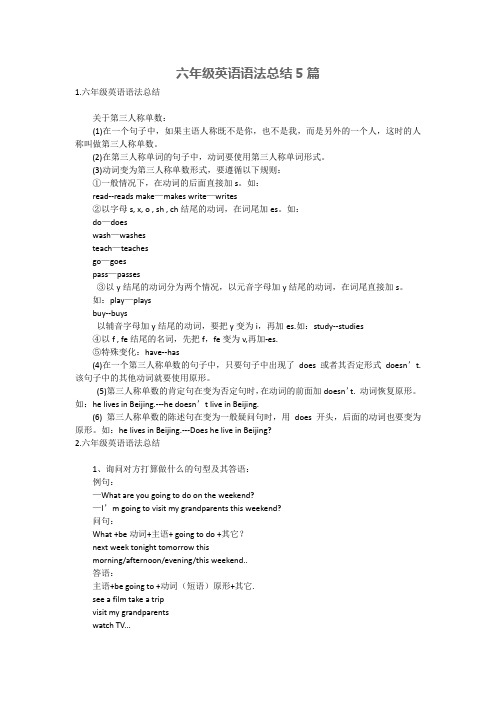
六年级英语语法总结5篇1.六年级英语语法总结关于第三人称单数:(1)在一个句子中,如果主语人称既不是你,也不是我,而是另外的一个人,这时的人称叫做第三人称单数。
(2)在第三人称单词的句子中,动词要使用第三人称单词形式。
(3)动词变为第三人称单数形式,要遵循以下规则:①一般情况下,在动词的后面直接加s。
如:read--reads make—makes write—writes②以字母s, x, o , sh , ch结尾的动词,在词尾加es。
如:do—doeswash—washesteach—teachesgo—goespass—passes③以y结尾的动词分为两个情况,以元音字母加y结尾的动词,在词尾直接加s。
如:play—playsbuy--buys以辅音字母加y结尾的动词,要把y变为i,再加es.如:study--studies④以f , fe结尾的名词,先把f,fe变为v,再加-es.⑤特殊变化:have--has(4)在一个第三人称单数的句子中,只要句子中出现了does或者其否定形式doesn’t.该句子中的其他动词就要使用原形。
(5)第三人称单数的肯定句在变为否定句时,在动词的前面加doesn’t. 动词恢复原形。
如:he lives in Beijing.---he doesn’t live in Beijing.(6) 第三人称单数的陈述句在变为一般疑问句时,用does开头,后面的动词也要变为原形。
如:he lives in Beijing.---Does he live in Beijing?2.六年级英语语法总结1、询问对方打算做什么的句型及其答语:例句:—What are you going to do on the weekend?—I’m going to visit my grandparents this weekend?问句:What +be动词+主语+ going to do +其它?next week tonight tomorrow thismorning/afternoon/evening/this weekend..答语:主语+be going to +动词(短语)原形+其它.see a film take a tripvisit my grandparentswatch TV...2、询问对方打算去哪儿的句型及答语:例句:—Where are you going this afternoon?—I’m going to the bookstore.问句:3、询问对方打算何时去做某事的句型及答语:例句:—When are you going to visit your grandparents?—I am going to visit my grandparents this afternoon.问句:When +be动词+主语+ going( to +动词原形)+其它?答语:主语+be动词+going to +动词(短语)原形+将来时间状语. 3.六年级英语语法总结1、如何询问对方的出行方式:How do/does+主语+go/come(to)+地点?你(们)怎么来···的?2、如何用must表示必须做某事:某人+must+动词原形(+其它). ···必须···3、告诫别人不要做某事的句型:Don’t +动词原形(+其它). 不要/别···①询问对方出行方式用疑问代词how—How do you go/come to school ? 你怎样去/来上学?—Usually I go/come to school on foot . 通常我走路去/来上学。
六年级英语语法与句型知识点

1. 一般现在时:句子中的主语用第三人称单数时,动词需加s或es。
如:She likes ice cream.2. 一般过去时:句子中的主语要用过去式动词。
如:He played football yesterday.3. 现在进行时:由“be + 动词的ing形式”构成,表示当前正在进行的动作。
如:They are watching TV now.4. 一般将来时:表示将来发生的动作或存在的状态。
如:I will go to the park tomorrow.5. 祈使句:用来表达请求、命令、劝告等,一般省略主语。
如:Do your homework now.6. 定义性从句:用来对主句中的名词进行解释或给出相关信息。
如:The book that is on the table is mine.7. 状语从句:用来表示时间、地点、原因、条件等,常用连词如when、where、because、if等引导。
如:I will go to bed when Ifinish my homework.8. 三单形式:动词的第三人称单数形式,一般在动词原形后加s、es。
如:He reads books every day.9. 比较级与最高级:用于比较两个事物的大小、程度等。
比较级在两个事物之间进行比较,最高级表示在三个以上的事物之间进行比较。
如:This book is longer than that one. This is the tallest buildingin the city.10. 反意疑问句:附在陈述句结尾,表示征求对方的意见或肯定。
一般与陈述句的人称、时态保持一致。
如:You like swimming, don't you?11. 疑问句:用于询问信息,一般由助动词、系动词或疑问词引导。
如:Can you swim? What is your name?12. There be句型:表示处存在人或物的状态。
英语六年级语法知识点
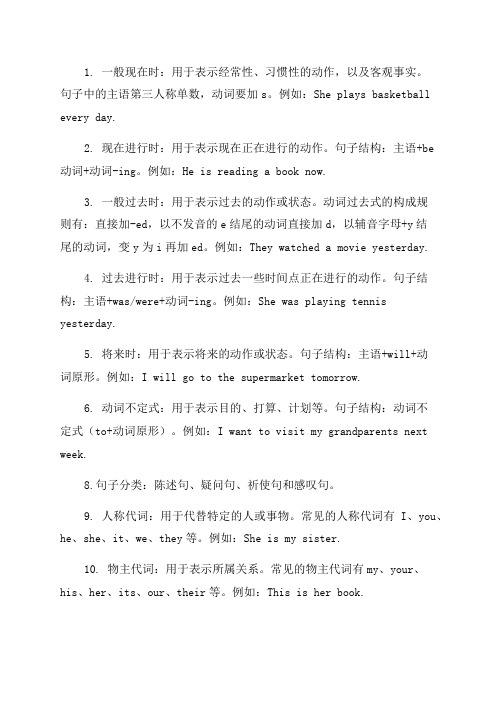
1. 一般现在时:用于表示经常性、习惯性的动作,以及客观事实。
句子中的主语第三人称单数,动词要加s。
例如:She plays basketball every day.2. 现在进行时:用于表示现在正在进行的动作。
句子结构:主语+be动词+动词-ing。
例如:He is reading a book now.3. 一般过去时:用于表示过去的动作或状态。
动词过去式的构成规则有:直接加-ed,以不发音的e结尾的动词直接加d,以辅音字母+y结尾的动词,变y为i再加ed。
例如:They watched a movie yesterday.4. 过去进行时:用于表示过去一些时间点正在进行的动作。
句子结构:主语+was/were+动词-ing。
例如:She was playing tennis yesterday.5. 将来时:用于表示将来的动作或状态。
句子结构:主语+will+动词原形。
例如:I will go to the supermarket tomorrow.6. 动词不定式:用于表示目的、打算、计划等。
句子结构:动词不定式(to+动词原形)。
例如:I want to visit my grandparents next week.8.句子分类:陈述句、疑问句、祈使句和感叹句。
9. 人称代词:用于代替特定的人或事物。
常见的人称代词有I、you、he、she、it、we、they等。
例如:She is my sister.10. 物主代词:用于表示所属关系。
常见的物主代词有my、your、his、her、its、our、their等。
例如:This is her book.11. 形容词比较级和最高级:用于表示两个以上事物的比较。
形容词的比较级通常在词尾加-er,最高级在词尾加-est,部分形容词需加more和most。
例如:He is taller than his brother.12. 数词:用于表示数量的词汇,分为基数词和序数词。
(完整版)小学六年级英语语法及词汇汇总
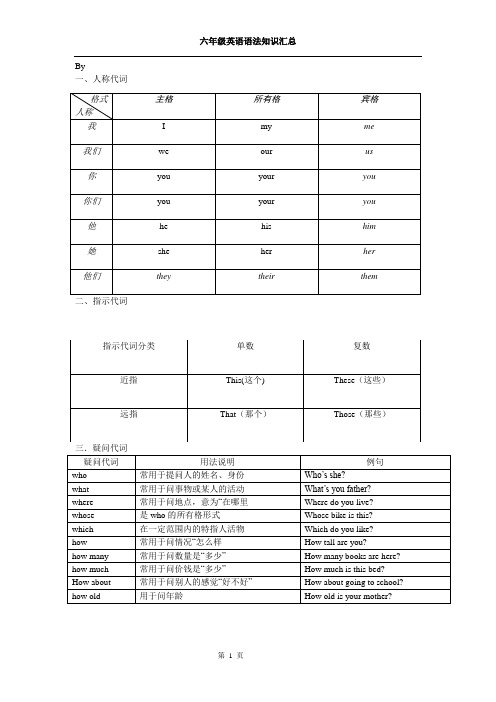
By一、人称代词二、指示代词四、不定代词一、词类:1、动词:行为动词、be动词、情态动词。
(1)行为动词原形、+s/es、+ed、+ing,具体判断方法如下:(2)be动词a、Am--was Is --was Are--were 口诀:我用am, 你用are, is用在他她它,所有复数全用are。
b、肯定和否定句I am (not) from London. He /She is(not) a teacher. My hair is(not) long. Hereyes are(not) small.c、一般疑问句Am I …? Yes, you are. No, you aren’t. Are you/they…? Yes,we/ they are.No,we/ they aren’t. Is the cat fat? Yes, it is. No, it isn’t.is、am、are为一类,一般用于一般现在时、现在进行时和一般将来时中。
was和were为另一类,一般用于一般过去时。
(3)情态动词can、must、should、would、may。
情态动词后动词总是用原形。
(不受其他任何条件影响)2、名词这里强调两点:不可数名词都默认为单数,所以总是用is或者was。
如何加后缀:a.一般情况下,直接加-s,如:book-books, bag-bags, cat-cats, bed-bedsb.以s. x. sh. ch结尾,加-es,如:bus-buses, box-boxes, brush-brushes, watch-watchesc.以“辅音字母+y”结尾,变y为i, 再加-es,如:family-families, strawberry-strawberries d.以“f或fe”结尾,变f或fe为v, 再加-es,如:knife-knivese.不规则名词复数:man-men, woman-women, policeman-policemen, policewoman-policewomen,mouse-mice child-children foot-feet ,.tooth-teeth fish-fish, people-people,Chinese-Chinese, Japanese-Japanese3、形容词(包括副词)形容词表示某一事物或的特征,副词表示某一动作的特征。
六年级的英语语法知识点
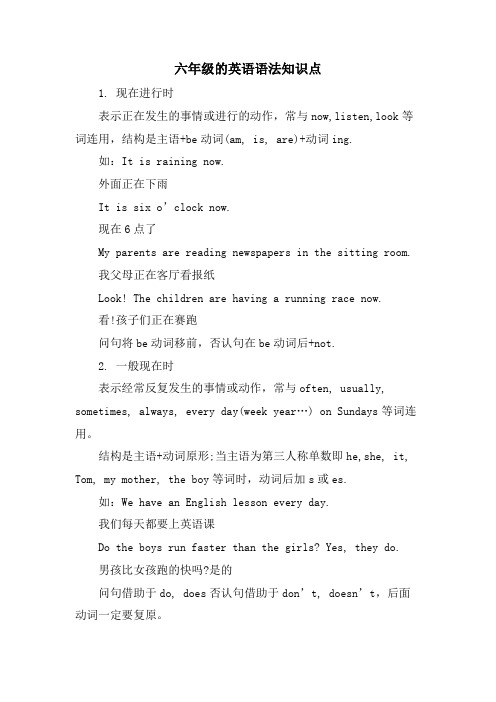
六年级的英语语法知识点1. 现在进行时表示正在发生的事情或进行的动作,常与now,listen,look等词连用,结构是主语+be动词(am, is, are)+动词ing.如:It is raining now.外面正在下雨It is six o’clock now.现在6点了My parents are reading newspapers in the sitting room.我父母正在客厅看报纸Look! The children are having a running race now.看!孩子们正在赛跑问句将be动词移前,否认句在be动词后+not.2. 一般现在时表示经常反复发生的事情或动作,常与often, usually, sometimes, always, every day(week year…) on Sundays等词连用。
结构是主语+动词原形;当主语为第三人称单数即he,she, it, Tom, my mother, the boy等词时,动词后加s或es.如:We have an English lesson every day.我们每天都要上英语课Do the boys run faster than the girls? Yes, they do.男孩比女孩跑的快吗?是的问句借助于do, does否认句借助于don’t, doesn’t,后面动词一定要复原。
3. 一般过去时表示发生在过去的事情或存在的状态,常与just now; a moment ago; … ago; yesterday; last ( week; month; year; Monday; weekend); this morning等词连用。
结构是主语+be动词的过去式(was; were)或主语+动词的过去式。
注意:be动词与动词过去式不可同时使用。
如:My earphones were on the ground just now.我的耳机刚刚还在呢。
- 1、下载文档前请自行甄别文档内容的完整性,平台不提供额外的编辑、内容补充、找答案等附加服务。
- 2、"仅部分预览"的文档,不可在线预览部分如存在完整性等问题,可反馈申请退款(可完整预览的文档不适用该条件!)。
- 3、如文档侵犯您的权益,请联系客服反馈,我们会尽快为您处理(人工客服工作时间:9:00-18:30)。
一、人称代词一、词类:1、动词:行为动词、be动词、情态动词。
(1)行为动词原形、+s/es、+ed、+ing,具体判断方法如下:(2)be动词a、Am--was Is --was Are--were 口诀:我用am, 你用are, is用在他她它,所有复数全用are。
b、肯定和否定句I am (not) from London. He /She is(not) a teacher. My hair is(not) long. Her eyes are(not) small.c、一般疑问句Am I …? Yes, you are. No, you aren’t. Are you/they…? Yes,we/ they are.No,we/ they aren’t. Is the cat fat? Yes, it is. No, it isn’t.is、am、are为一类,一般用于一般现在时、现在进行时和一般将来时中。
was和were为另一类,一般用于一般过去时。
(3)情态动词can、must、should、would、may。
情态动词后动词总是用原形。
(不受其他任何条件影响)2、名词这里强调两点:不可数名词都默认为单数,所以总是用is或者was。
如何加后缀:a.一般情况下,直接加-s,如:book-books, bag-bags, cat-cats, bed-beds b.以s. x. sh. ch结尾,加-es,如:bus-buses, box-boxes, brush-brushes, watch-watchesc.以“辅音字母+y”结尾,变y为i, 再加-es,如:family-families, strawberry-strawberriesd.以“f或fe”结尾,变f或fe为v, 再加-es,如:knife-knivese.不规则名词复数:man-men, woman-women, policeman-policemen, policewoman-policewomen,mouse-mice child-children foot-feet ,.tooth-teeth fish-fish, people-people, Chinese-Chinese, Japanese-Japanese3、形容词(包括副词)形容词表示某一事物或的特征,副词表示某一动作的特征。
形容词和副词只有两种形式:原形和+er。
未作比较的情况下就用原形,比较时就+er。
两个重要特征:as……as中间一定用原形,有than的时候一定+er。
4、人称代词和物主代词人称代词物主代词单数复数单数复数主格宾格主格宾格形容词性(短)名词性(长)形容词性(短)名词性(长)第一人称Imeweusmymineourours第二人称youyouyouyouyouryoursyouryours第三人称hehimtheythemhishistheirtheirssheherherhersitititsits人称代词:有主格和宾格之分。
一般动词前用主格,动词后用宾格。
物主代词:有两类:形容词性物主代词(短的)和名词性物主代词(长的)一般看后面有没有名词,如有,就用形容词性物主代词(短的);如无,就用名词性物主代词(长的)。
5、数量词我们学过两类:基数词和序数词。
基数用于表示数量多少,而基数词用于表示次序,常在日期中出现。
序数词的前面一般都加the。
6、冠词有a、an、the。
a和an的区别:an用于元音音素(一般就是元音字母aeiou)前,a用于辅音音素前。
二、否定句:be动词(am、is、are、was、were)+not、情态动词(can、must、should)+ not、助动词(do、does、did)+ not如何将一个肯定的陈述句改为否定句:1、看句中有无be动词,如有,直接在be动词后+ not。
2、看句中有无情态动词,如有,直接在情态动词后+ not。
3、如上述二者都没有,就应用助动词+ not。
分四个步骤:(1)肯定陈述句中本来是没有助动词的,要加上去,位置在主语(某人或某物)后,动词前。
(2)确定助动词用do、does还是did,根据句中动词,动词是原形的助动词就用do,动词是第三人称单数的助动词就用does,动词用过去式的助动词就有did。
(3)在助动词后加not。
(4)原句中动词假如发生变化就要恢复成原形。
强调一点,有some的要考虑是否要用any。
三、一般疑问句。
如何将一个肯定的陈述句改为否定句:1、看句中有无be动词,如有,把be动词提到句首即可。
2、看句中有无情态动词,如有,把情态动词提到句首即可。
3、如上述二者都没有,就应把助动提到句首。
分四个步骤:(1)肯定陈述句中本来是没有助动词的,要加上去,位置在主语(某人或某物)后,动词前。
(2)确定助动词用do、does还是did,根据句中动词,动词是原形的助动词就用do,动词是第三人称单数的助动词就用does,动词用过去式的助动词就有did。
(3)把助动词后提到句首。
(4)原句中动词假如发生变化就要恢复成原形。
强调一点,有some的要考虑是否要用any。
四、特殊疑问句。
表示疑问,有疑问词(在开头),回答有很多种可能。
常用疑问词:疑问词意思用法When什么时间问时间What time 什么时间问具体时间,如几点钟Who谁问人Whose 谁的问主人Where在哪里问地点Which哪一个问选择Why 为什么问原因What 什么问东西、事物What colour什么颜色问颜色What about。
怎么样问意见What day星期几问星期几What date什么日期问日期What for 为何目的问目的How 。
怎样问情况How old多大年纪问年纪How many多少数量(可数名词)问数量How much多少钱;多少数量(不可数名词)问多少钱或数量(不可数)How about。
怎么样问意见How often多久问频率How long多长时间问时间长度How far 多远问多远;多长距离五、祈使句表示请求或命令别人做某事或不要做某事。
肯定祈使句一定是以动词原形开头(有时有please),否定的祈使句一定是don’t加动词原形开头(有时有please)。
把祈使句改为否定句只需在动词前加don’t即可。
六、时态1、一般现在时(1)一般现在时中的be动词:一般用原形:am is aream用于第一人称单数(I);is用于第三人称单数(he she it和其他人名或称谓,如:Ben hissister等);are用于第二人称单数(you)和所有复数(包括第一人称复数we、第二人称复数you;第三人称复数they和其他复数,如thechildren 、his parents等)。
(2)一般现在时中的动词:第一种情况:主语是第三人称单数(he she it 和其他,如Helen 、her cousin 等),动词后一般加s或es。
第二种情况:主语不是第三人称单数,动词都用原形。
(4)一般现在时判断依据(如何判断一个句子是一般现在时):△be动词是am、is、are△动词用原形或加s、es△没有时间状语或有usually、often、everyday、sometimes等不是具体的时间2、一般过去时(1)一般过去时中的be动词:一般用过去式:was werewas用于第一人称单数(I)和第三人称单数(he she it和其他人名或称谓,如:Ben 、hissister等);were用于第二人称单数(you)和所有复数(包括第一人称复数we、第二人称复数you;第三人称复数they和其他复数,如thechildren 、his parents等)。
(2)一般过去时中的动词:一般只有一种情况:+ed这里强调一点,和一般现在时不同的是这里不管主语是第几人称,也不管是单数和复数都加ed。
(4)一般过去时判断依据(如何判断一个句子是一般过去时):△be动词是was、were △动词加ed△有表示过去的时间状语现在学过的常用的表示过去的时间状语有:just now a moment ago yesterday last week last night last weekend last year last month three days ago two weeksagofive years ago this morning3、一般将来时(1)构成形式:Be going to +动词原形,will + 动词原形(2)一般将来时表示动作即将发生或某人打算做某事。
(3)句中往往有tomorrow、soon、next week等词。
4、现在进行时(1)构成形式:Be动词+动词的ing形式这里强调一点,两者缺少其中任何一种都不可以构成现在进行时。
(2)现在进行时表示动作正在进行或事情正在发生。
(3)有用的依据:一个句子中既有be动词,又有动词,且动词加了ing ←→该句是现在进行时(4)句中往往有now、look、listen等词。
动词过去式、现在分词的不规则变化:be 是——was, were——being begin 开始——began——beginningbuild 建筑——built——building buy 买——bought——buyingcan 能——could——无come 来——came——comingcopy 拷贝——copied——copying do 做——did——doingdraw 画——drew——drawing drink 喝——drank——drinkingdrive 驾车——drove——driving eat 吃——ate——eatingfeel 感觉——felt——feeling find 找寻——found——findingfly飞——flew——flying forget 忘记——forgot——forgettingget 得到——got——getting give 给予——gave——givinggo 去——went——going grow 成长——grew——growinghave 有——had——having hear 听——heard——hearingkeep 保持——kept——keeping know 知道——knew——knowing learn学习—learnt, learned——learning let 让——let——lettingmake 做——made——making may 可以——might——无mean 意思——meant-meaning meet 见面——met——meetingmust 必须——must——无put 放——put——puttingread 读——read——reading ride 骑——rode——ridingring 响——rang——ringing run 跑——ran——runningsay 说——said——saying see 看见——saw——seeingsing 唱歌——sang——singing sit 坐——sat——sittingsleep 睡觉——slept——sleeping speak 讲话——spoke——speaking spend 花钱——spent——spending stand 站立——stood——standing sweep 打扫——swept——sweeping swim 游泳——swam——swimming take 拿到——took——taking teach 教——taught——teaching tell 讲述——told——telling think 思考——thought——thinking will 意愿——would——无write 写——wrote——writi。
